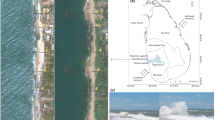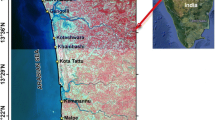Abstract
Man-made coastal structures directly affect sediment balance and sediment dynamics on the surrounding beaches. The Colombo Harbor Expansion Project has created about 5-km-long breakwater nearly perpendicular to the beach. The present study is focused on quantitatively and qualitatively analyzing the effect of the Colombo Harbor Expansion Project on economically important beaches in and around Colombo city area. In this study, the authors measured monthly variations of beach width, beach profile and the mean grain-size of the sediments at mean sea level for complete annual monsoon cycle. Data were analyzed to establish site-specific erosion vulnerability. Monitoring results show that cumulative beach erosion has increased after the construction of the breakwater (rate = 0.7 m/year from May 2000 to April 2011 and rate = 28.2 m/year from April 2011 to June 2012). In addition, the cumulative and site-specific sand accretion and erosion patterns have a clear relationship with the monsoon seasonality. Beaches were narrower during the stormy southwestern monsoon, whereas beaches were wider during fair weather of northeast monsoon and inter-monsoon periods. In contrast, the constructed breakwater obstructs natural longshore sediment dynamics. For example, a significant amount of sediments from the Kelani-Ganga River were buried in the Colombo Harbor due to alteration of prominent longshore sediments transportation on the western coast of Sri Lanka. Therefore, this study shows enhancement of coastal erosion in the studied southern beaches due to a lack of sediment deposition.






Similar content being viewed by others
References
Anderson TR, Fletcher CH, Barbee MM, Frazer LN, Romine BM (2015) Doubling of coastal erosion under rising sea level by mid-century in Hawaii. Nat Hazards 78:75–103
Becker M, Meyssignac B, Letetrel C, Llovel W, Cazenave A, Delcroix T (2012) Sea level variations at tropical Pacific islands since 1950. Glob Planet Chang 80–81:85–98
Carter CH, Guy DE Jr (1988) Coastal erosion: processes, timing and magnitudes at the bluff toe. Mar Geol 84:1–17
Cooper JAG, Pilkey OH (2004) Sea-level rise and shoreline retreat: time to abandon the Bruun Rule. Glob Planet Chang 43:157–171
El-Asmar HM, White K (2002) Changes in coastal sediment transport processes due to construction of New Damietta Harbour, Nile Delta, Egypt. Coast Eng 46:127–138
Ells K, Murray AB (2012) Long-term, non-local coastline responses to local shoreline stabilization. Geophys Res Lett 39:L19401. https://doi.org/10.1029/2012GL052627
Gibb JG (1978) Rates of coastal erosion and accretion in New Zealand. New Zeal J Mar Fresh Res 12:429–456
Goto K, Takahashi J, Oie T, Imamura F (2011) Remarkable bathymetric change in the nearshore zone by the 2004 Indian Ocean tsunami: Kirinda Harbor, Sri Lanka. Geomorphology 127:107–116
Harper JR (1978) Coastal erosion rates along the Chukchi Sea coast near Barrow, Alaska. Arctic 31:428–433
Jevrejeva S, Moore JC, Grinsted A (2012) Potential for bias in 21st century semiempirical sea level projections. J Geophys Res 117:D20116. https://doi.org/10.1029/2012JD017704
Kaliraj S, Chandrasekar N, Magesh NS (2013) Evaluation of coastal erosion and accretion processes along the southwest coast of Kanyakumari, Tamil Nadu using geospatial techniques. Arab J Geosci 8:239–253
Katupotha J, Fujiwara K (1988) Holocene sea level change on the southwest and south coasts of Sri Lanka. Palaeogeogr Palaeoclimatol Palaeoecol 68:189–203
Kumar TS, Mahendra RS, Nayak S, Radhakrishnan K, Sahu KC (2010) Coastal vulnerability assessment for Orissa State, east coast of India. J Coast Res 26:523–534
Masselink G, Russell P, Turner I, Blenkinsopp C (2009) Net sediment transport and morphological change in the swash zone of a high-energy sandy beach from swash event to tidal cycle time scales. Mar Geol 267:18–35
Miles JR, Russell PE (2004) Dynamics of a reflective beach with a low tide terrace. Cont Shelf Res 24:1219–1247
Nayanananda OK (2007) The study of economic significance of coastal region of Sri Lanka in the context of environmental changes of pre and post tsunami. Coast Conservation Department, The Ministry of Environment and Natural Resources, Sri Lanka
Phillips MR, Jones AL (2006) Erosion and tourism infrastructure in the coastal zone: problems, consequences and management. Tour Manag 27:517–524
Rangel-Buitrago N, Anfuso G (2013) Winter wave climate, storms and regional cycles: the SW Spanish Atlantic coast. Int J Climatol 33:2142–2156
Rangel-Buitrago NG, Anfuso G, Williams AT (2015) Coastal erosion along the Caribbean coast of Colombia: magnitudes, causes and management. Ocean Coast Manag 114:129–144
Rao KN, Subraelu P, Rao TV, Malini BH, Ratheesh R, Bhattacharya S, Rajawat AS (2008) Sea-level rise and coastal vulnerability: an assessment of Andhra Pradesh coast, India through remote sensing and GIS. J Coast Conserv 12:195–207
Ratnayake AS (2016) Evolution of coastal landforms during the Holocene Epoch along the west and southeast coasts of Sri Lanka. Interdiscip Environ Rev 17:60–69
Ratnayake AS, Sampei Y, Ratnayake NP, Roser BP (2017) Middle to late Holocene environmental changes in the depositional system of the tropical brackish Bolgoda Lake, coastal southwest Sri Lanka. Palaeogeogr Palaeoclimatol Palaeoecol 465:122–137
Ratnayake NP, Ratnayake AS, Azoor RM, Weththasinghe SM, Seneviratne IDJ, Senarathne N, Premasiri R, Dushyantha, N (under review) Performance analysis of the beach nourishment and breakwater construction to control the coastal erosion at Uswetakeiyawa, Sri Lanka. J Coast Conserv
Rosen PS (1978) A regional test of the Bruun Rule on shoreline erosion. Mar Geol 26:M7–M16
Ruggiero P, Komar PD, McDougal WG, Marra JJ, Beach RA (2001) Wave runup, extreme water levels and the erosion of properties backing beaches. J Coast Res 17:407–419
Schwartz ML (1965) Laboratory study of sea-level rise as a cause of shore erosion. J Geol 73:528–534
Schwartz ML (1967) The Bruun theory of sea-level rise as a cause of shore erosion. J Geol 75:76–92
Syvitski JP, Vörösmarty CJ, Kettner AJ, Green P (2005) Impact of humans on the flux of terrestrial sediment to the global coastal ocean. Science 308:376–380
Van Rijn LC (2011) Coastal erosion and control. Ocean Coast Manag 54:867–887
Zhang K, Douglas BC, Leatherman SP (2004) Global warming and coastal erosion. Clim Change 64:41–58
Zhou L, Liu J, Saito Y, Zhang Z, Chu H, Hu G (2014) Coastal erosion as a major sediment supplier to continental shelves: example from the abandoned Old Huanghe (Yellow River) delta. Cont Shelf Res 82:43–59
Acknowledgements
We would like to thank A.R. Amarasinghe and H.M.S.D. Gunathilake of the Oceanography Laboratory for providing assistance in the field works.
Author information
Authors and Affiliations
Corresponding author
Rights and permissions
About this article
Cite this article
Ratnayake, N.P., Ratnayake, A.S., Keegle, P.V. et al. An analysis of beach profile changes subsequent to the Colombo Harbor Expansion Project, Sri Lanka. Environ Earth Sci 77, 24 (2018). https://doi.org/10.1007/s12665-018-7234-8
Received:
Accepted:
Published:
DOI: https://doi.org/10.1007/s12665-018-7234-8




